
おもしろ体験博物館
江戸民具街道でじたる案内人
Japanese Folk Art Museum
Edo Mingu Kaido Digital Guide
Home >モース博士と日本 (Prof. Morse and Japan)
モース博士と日本に関する興味深い情報を紹介します!
Here are the interesting information about Prof. Morse and Japan!

1.モース博士はご存知でしょうか?
Do you know Prof. Morse?
モース博士は明治初期に日本に滞在した米国人動物学者です。モース博士は明治時代に合計3回来日していますが、明治10年(1877年)最初に日本に来た目的は腕足類についての調査をすることでした。飛行機のない時代にモース博士は船に乗り、約2週間かけて1877年6月に横浜港に到着します。来日後すぐにモース博士は文部省に生物採集の許可を得るべく東京に向かいますが、横浜から東京に向かう汽車の窓から外の景色を眺めている時に、大森の駅を過ぎたあたりで貝塚を発見します。モース博士といえばこの大森貝塚の発見者として、考古学の分野でも名前が知られています。
Prof. Morse, an American zoologist, stayed in
Japan in the early Meiji Period. Prof. Morse came to Japan three time in
the Meiji Period; his first visit to Japan in 1877 was to study coastal
brachiopods. He arrived at Yokohama Port on a ship in June 1877. To get
the official approval for biological study and the collection of specimens, he
visited the Ministry of Education located in Tokyo; on the way to Tokyo from
Yokohama on a train, he discovred a shell mound while looking out of a window.
Prof. Morse is known as a discoverer of this shell mound known as Omori Shell
Mound and a archaeologist who opened the study in archaeology in Japan.
| モース博士関連 | 内容 |
| モース博士の生い立ち Personal History of Prof. Morse |
エドワード・シルベスター・モース/Edward Sylvester Morse ・1838年、米国メーン州ポートランドに生まれる。/Born in Portland, Maine in the United States. ・少年時代から貝の収集を始める。/Started collecting shells in his boyhood. ・高校を中退し、製図工を2年務める。/Quited highschood and worked as a draftsman for two years. ・1859年、21歳の時にハーバード大学ルイ・アガシー教授の学生助手となる。/Became an assistant of Louis Agassiz at Harvard University ・1867年、アメリカン・ナチュラリスト誌の創刊に協力する。 ・1875年、アメリカ科学振興協会の副会長になる。また動物学初歩の教科書を出版する。Published First Book of Zoölogy ・1877年6月、38歳の時にシャミセン貝の研究のために来日するが、汽車の窓から大森貝塚を発見する。江の島で海洋生物の収集・研究を行う。東京大学でお雇い教師として動物学を教える。Came to Japan to study brachiobod and he was offered a post as the first professor of Zoology at the Tokyo Imperial University. He was 38 at that time. ・1878年、家族と共に二度目の来日を果たす。東京大学で教授を務める。日本で進化論の講演を行う。The 2nd time visit to Japan with his family and became a proffesor at Tokyo Univercity. He tought the theory of evolution in Japan. ・1879年、「大森貝塚」を刊行。Published the book titled "Shell Mounds of Omori". ・1880年、帰国後セイラムにあるピーボディー科学アカデミーの館長となる。Became a director of the Peabody Academy of Science. ・1882年、三度目の来日を果たす。陶器類の収集を行う。The 3rd visit to Japan and collected Japanesae potteries. ・1886年、「日本の住まい」を発刊。Published the book titled "Japanese Homes and their Surroundings" ・1901年、「日本陶器モース・コレクション目録」を刊行。Published a book titled "Catalogue of the Morse collection of Japanese pottery" ・1902年、「生きている腕足類の観察」を発表。 ・1917年、「日本その日その日」を刊行。Published the book titled "Japan Day by Day" ・1925年12月、87歳でこの世を去る。Past way at his age 87. |
2.モース博士と江の島
Prof. Morse and Enoshima
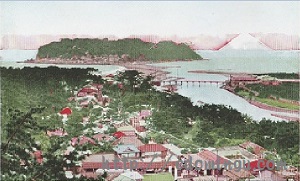
モース博士は1877年7月から8月にかけて約一か月間江の島に滞在し、海洋生物の採集・調査を行いました。モース博士は江の島の海辺にある漁師の小屋を改築し、あかりを取るためのスライド式の窓、作業台、椅子、棚を作り、臨海実験室にしたのでした。モース博士が主たる研究対象としたのがシャミセン貝です。当時江の島近海にはシャミセン貝が数多く生息していました。
Prof. Morse stayed at Enoshima, a small
offshore Island in Kanagawa Prefecture, for about a month between July and
August in 1877 to collect marine specimens and research and study marine
biology. He rent a fisherman's shed by the sea and attached sliding
windows, equipped with work bench and stools, and shelves, turning it into a
laboratory. His main forcus was to research brachiopods. There were
numbers of brachiopods lived in the water by Enoshima Island.
| モース博士関連 | 内容 |
| シャミセン貝 Brachiopods |
シャミセン貝は殻を持っていて、一見貝のように見えますが、実際には軟体動物の貝とは異なります。シャミセン貝の学術名はBrachiopodで、ギリシャ語の腕と足を掛け合わせた言葉になり、腕足動物と呼ばれています。モース博士は少年時代から貝に興味を持ち、ダーウィンの動物進化論を支持する過程でシャミセン貝を研究の対象に選んだと言われています。
Brachiopod has valves and looks like a shell though it differs. The word Brachiopod is formed from the Ancient Greek words of arm and foot. Prof. More had great interest in collecting and studying snails and shells since he was a young boy and it is said that he chose Brachiopod as a study subject in the course of supporting Darwin's theory of evolution.  緑三味線貝。殻の長さ約3.5cm。 Green Brachiopod. The length of the shell is about 3.5cm. |
| 江の島臨海実験所 Enoshima marine laboratory |
モース博士は海洋生物が豊富に生息する江の島を研究の地に選び、漁師の小屋を改築して実験所を作ります。底引きをした初日には200匹ものシャミセン貝を捕まえます。ここで海洋生物の標本を作製します。この場所は日本で最初の臨海実験所となり、日本近代動物学発祥の地とも呼ばれています。 Prof. Morse chose Enoshima, where there were abundant marine specimens, as the place for his research and he turned a fisherman's shed into research facility. On the first day of dredging, he caught 200 brachiopods. He collected and made specimens of marine life there. This became the first marine laboratory in Japan and also a birthplace of Japanese modern zoology. 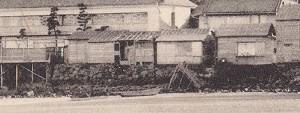 明治40年の写真。真ん中に写っているのが臨海研究所に使われた小屋。 A photo taken in 1907. One in the middle could be a shed used as the laboratory. 弁財天仲見世通り入口にある青銅の鳥居をくぐってすぐ左側にある路地を進むと、右側に江の島モース臨海実験所跡推定地の碑が設置されています。江の島沿岸の埋め立てが進む前は上記写真のようにここは岸壁であった場所になります。 Turn to the left right after going through the cupper made shrine gate at the entrance of Enoshima, and you can find a sign showing an estimated position where Prof. Morse's laboratory was located. Before reclamation, it was by the quay as the above photo shows.  |
3.モース博士と大森貝塚
Prof. Morse and Omori Shell Mound
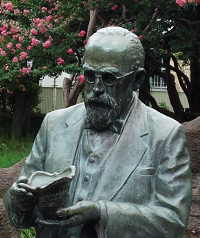
江の島臨海実験所での一か月に及ぶ生物採集・調査を終えたモース博士1877年10月に汽車の窓から見つけた貝塚の本格的な発掘調査を始めます。貝塚とは海辺に住む古代人が食べた貝の殻を捨てた場所で、この貝殻が積み重なり、更にその上に土が堆積して地層の一部となったものです。モース博士が汽車の中から発見した貝塚は大森駅の先で見つかったことから大森貝塚と名づけられました。この貝塚からは貝殻のみならず、土器や骨等が出土しています。モース博士は発掘した土器に刻まれた模様を見て、Cord-Markedと呼びました。粘土に縄を押し付けて形作った模様という意味で、この言葉は日本語で縄文と訳されました。モース博士が名付けたこの言葉が縄文土器や縄文時代の語源となったのです。
After having stationed in his laboratory in
Enoshima Island for a month researching marine biology, he started excavation of
the shell mound that he found from a train window in October 1877. Since
the shell mound that he found was located close to Omori Station, it was named
Shell mounds of Omori. In the shell mounds, the remains of shells along with ancient earthenware and
bones were unearthed. He observed the decorative patterns inscribed on the
surface of earthenware and called them Cord Marked, meaning rope patterns which
were created by impressing
cords into wet clay. The word Jomon earthenware and the Jomon
period were derived from the term that Prof. Morse devised.
| モース博士関連 | 内容 |
| 大森貝塚 Shell mounds of Omori |
JR大森駅と品川駅の間の線路沿い大森貝塚の石碑が建っています。石碑は2つありますが、品川側の石碑がモース博士が発見した貝塚の場所として日本の考古学発祥の地とされています。ここは遺跡庭園として整備されており、庭園の中心にはモース博士の銅像が置かれています。まるでモース博士がそこでたたずんでいるような錯覚を覚えるほど良くできています。 There are stone monuments of Shell mounds of Omori along the railroad tracks between Shinagawa Station and Omori Station of East Japan Railway. There are two stone monuments and the one in Shinagawa Ward is the place where the shell mound was found by Prof. Morse, which is now being a nicely maintained garden commemorating the birthplace of Japanese archaeology. There is a bronze statue of Prof. Morse in the center of the garden. 公園は大森の駅の北口から歩いて5分くらいのところにありますが、その途中のNTTデータのビル横の路地を入り、階段を降りると、もう一つの石碑を見ることができます。東京都大森貝塚保存会ではモース博士の偉業を称え、毎年献花式を行っています。モース博士が乗った汽車が大森駅を出発したすぐ先で車窓から貝塚が発見されたことから、JR大森駅のホームにも記念碑が建てられているのです。白い制服・制帽の大森駅駅長が自ら花束を捧げ、モース博士の偉業を称えています。 Another stone monument in Ota Ward is located by NTT Data building; you can walk down the stairs of the building, which is open to the public, where you will find a huge stone monument standing by the railroad commemorating the exploit of Prof. Morse. Every year, a ceremony to dedicate flowers is held by Tokyo Omori Shell Mounds Preservation Society. Since Prof. Morse found the shell mound from a window of a train right after the departure from Omori Station, there is a monument also on the platform of JR Omori Station; a floral tribute ceremony is also held there and the station master himself in his white uniform dedicate flowers to remember Prof. Morse. 東京都大森貝塚保存会ホームページ |
4.モース博士と日本の民族学
Prof. Morse and Japanese Ethnology

モース博士は日本人の文化、庶民の生活、生活の道具類にも興味を示しており、日本滞在中に目にしたものを記録に残しました。また日本の数多くの民具を母国に持ち帰っています。鎖国という時代の中で育まれた日本独自の文化は、西洋人の目からみれば奇異なものであったに違いありません。反対にそれはモース博士にとっては純朴で愛くるしいものでもあったのかもしれません。モース博士の日本その日その日を読むと、それは現代の日本人にとってもまるで異国のお話しのようでもありますが、それはほんの140年前のことなのです。
モース博士が訪れた江の島は日本近代動物学発祥の地とされ、大森貝塚は日本の考古学発祥の地とされていますが、日本の庶民の生活を記録として、そして道具類を保存されようとしたモース博士は、日本の民族学の父と呼んでもおかしくないと思われます。
Prof. Morse showed great interest in Japanese
culture, daily life of people, appliances and tools used by commoners, and he
recorded things that he saw during his stay in Japan. He also brought back
everyday articles. The unique culture of the Japanese developed during the
national isolation could have been strange and fantastic to the westerners.
On the other hand, it could have been honest and lovable to the eyes of Prof.
Morse. If you have ever read "Japanese Day by Day", you would have found
it something like a story of a foreign country, even to the Japanese now-a-days;
however, it was only 140 years ago.
今回はモース博士の大のお気に入りであった日本の民具をいくつかご紹介したいと思います。モース博士が執筆した日本滞在記「日本その日その日」そして「日本の家屋、内と外」の中には様々な民具や道具類が登場しますが、モース博士が特に注目したものをモース博士のコメントを織り交ぜながら、江戸民具街道のコレクションを使って紹介したいと思います。
Hereby, we would like to introduce some of the
old articles typical to Japan that Prof. Morse showed great interest. In
the books titled "Japan Day by Day" and "Japanese Homes and Their Surroundings"
written by Prof. Morse, .there are numbers of items that he described and among
them, we would like to introduce some of the items by referring to the
collections by Edo-Mingu-Kaido Folkat Museum.
①人力車(モース博士は人力車マニア?)
Jinrikisha (Was Prof. Morse Rick-sha mania?)
以下モース博士が初めて人力車に乗ったときのコメントです。モース博士は日本中を旅した時にも人力車を好んで利用しました。
The following is the comment by Prof. Morse when he
first experienced having ridden Jinrikisha. He used Jinrikisha during his
trips inland Japan.
モース博士のコメント/Comment by Prof. Morse
「我々は如何にも貧弱そうな乗物に乗り込んだのですが,私のみならず誰でもそう感じるであろうとは思いますが,人に引かれる乗り物に乗ることに対して抵抗感を感じてしまい,いっそのことこの車を下りて,ズボンもはかず脚丸出しのいでたちをしたこの男と交代した方がよっぽど気が楽ではないかとさえ思えたのですが,そのようなはずかしさにも似た気持ちはすぐに消え失せてしまいました。目の前にいる一人の男が自分の為にホテル迄の道のりを休みもせずに,まるでおいぼれた元競走馬が我を忘れて走り出したような勢いで駆け抜ける姿はなんとも爽快であり,午前中に遭遇した数々の出来事と同様に私にとっては驚くべき体験でした。人力車に乗ると上下にゆっくりと揺れ続けるので,それはなんともよい乗り心地です。人力車に乗れば十分な速度で移動できる上に,馬と違って逃げてしまうこともなく,駐車中には荷物の番までしてくれるのです。
(E. Morse, “Japan Day by Day”江戸民具街道翻訳)
"As
we stepped into the frail-looking vehicle I, for one, felt a sense of
humiliation in being dragged by a man and should have felt less embarrassed if I
could have got out and exchanged places with the naked-legged human. But
this feeling soon wore away, and the exhilaration of having a man ahead running
like the old scratch the entire distance to the hotel, without stopping, was as
surprising as most of the experiences of that morning.

②火消の道具(モース博士は大の火事場の野次馬?)
Firefighters equipment (Was Prof. Morse an
outstanding fire watcher?)
モース博士は火事が起きると夜中でも起きて見に行くほどの火事場好きであったようです。このため火消の道具にも興味をもっており、アメリカに帰るときに消防ポンプを持ち帰ったほどです。
Prof. Morse wake up and went out to watch a fire
everning at midnight. He showed his interest in firefighters equipment and
he even brought a water pump back to his country.
モース博士のコメント/Comment by
Prof. Morse
「日本に来てから数多くの驚くべき出来事を目にしましたが、中でも日本の火消しが火事場でとる行動ほど風変りなものはありません。消火ポンプはせいぜい長さ76センチ程度、頑丈に作られた木造の箱で、車輪はなく、シーソーのように上下に動かして水を汲み上げるための長い横棒が付いているのですが、二人の男がこれを棒の代わりにして肩にかつぎ何キロも運べるほど軽いのです。スケッチ112は消防署に保管されている消防ポンプの図で、小屋のような建物の壁面に二本の掛け釘が突き出ており、そこに引っ掛けるような形で置いてあるのです。その下に掛けてあるのは丈夫な竹でつくった梯子で、何本もの横木がしっかりと縛りつけられており、軽く強く実用的な梯子に仕上がっています。狭い路地さえうまくかわせれば、一人で担いで走ることが出来ます。消防ポンプにホースは付いていません。長さ180センチ程の木製の管が消防ポンプの本体中央から垂直に伸びた木管につながっているのですが、それが連結されている基部は上下左右に稼働する仕組みになっています。この消防ポンプを初めて目にした時は、火を消すために考案された装置としてはあまりにも馬鹿げた子供じみたものにしか見えませんでした。」
(E. Morse, “Japan Day by Day”江戸民具街道翻訳)
Of the many extraordinary sights I have thus far seen in Japan, a Japanese fire company in action at a fire goes beyond them all. The engine itself is not over two and a half feet long; a stout wooden box with no wheels, and so light that two men pick it up and carry it on their shoulders for miles, using the long beam, by which they pump it up and down, as a carrying-stick. The sketch (fig. 112) shows the engine at rest at the fire station hanging on two pegs from the side of a shed-like building. Below this hangs a ladder made of stout bamboo the rungs of which, consisting of stripes of wood, are firmly tied, making a light, strong, and serviceable ladder. One man can easily run with this if he can steer it through the narrow streets. There is no hose. A wooden pipe, six feet in length, is joined to an upright wooden pipe which rises from the center of the engine and is jointed at the base in such a way that it may be made to move up and down, or from side to side. It seemed the most ridiculous and puerile device ever conceived for the purpose of extinguishing fires. (E. Morse, Japan Day by Day)
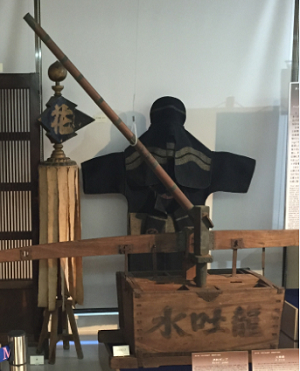
③大工さんとその道具
Carpenter's tools
モース博士は日本の大工さんの水準の高さに驚いています。どんな田舎町にいっても都市部と変わらない丁寧な仕事をしていることに着目しています。大工道具の中では墨壺に興味を示しており、アメリカの大工も使うべきだと絶賛しています。
Prof. Morse made remarks about a high level
techinical standard of Japnese carpenters. Even in the buildings in a
country side, they were perfectly finished no less equivalent to these that
could be seen in city areas. Among carpenter's tools, he described about
ink-pod and he commented that it should be adopted by the American carpenters.
モース博士のコメント/Comment by
Prof. Morse
「大工は木材を彫って作ったある道具を持っています。墨に浸した綿の入った容器に紐を巻き付けた車輪が付いているのですが、紐を引き伸ばしたり巻いたりする時にその紐が綿の中を通るようになっているのです。紐の先端には錐(きり)が付いていて、引き伸ばした紐を板に固定してから、その紐を持ち上げてパチンと放すだけで墨の線が引けるという具合です。我国アメリカでは大工はチョークで線を引いていますが、この道具を使えば黒くはっきりとした消えにくい線が引けるので、我が国の大工もこの道具を使うべきでありましょう。
The
carpenter has a device, carved out of
wood, consisting of a
receptacle holding ink-saturated cotton, and a wheel on which a cord is wound,
the cord passing through the cotton as it is wound and unwound. The cord
has an awl attached to it, and the carpenter makes an ink line on the board by
pulling the string out and with the awl fastening it to the board and then
snapping it, as our carpenter does his chalk-line. The device should be
adopted by our carpenters, as it makes a sharp, black, durable line. (E. Morse,
Japan Day by Day)
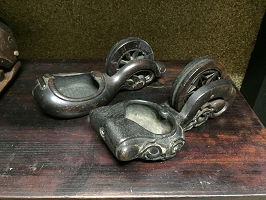
おもしろ体験博物館江戸民具街道
神奈川県足柄上群中井町久所418
0465-81-5339
Japanese Folk Art Museum "Edo Mingu Kaido"
Address: 418 Kuzo, Nakai-machi, Ashigara-kamigun, Kanagawa-ken, Japan
Tel: 0465-81-5339